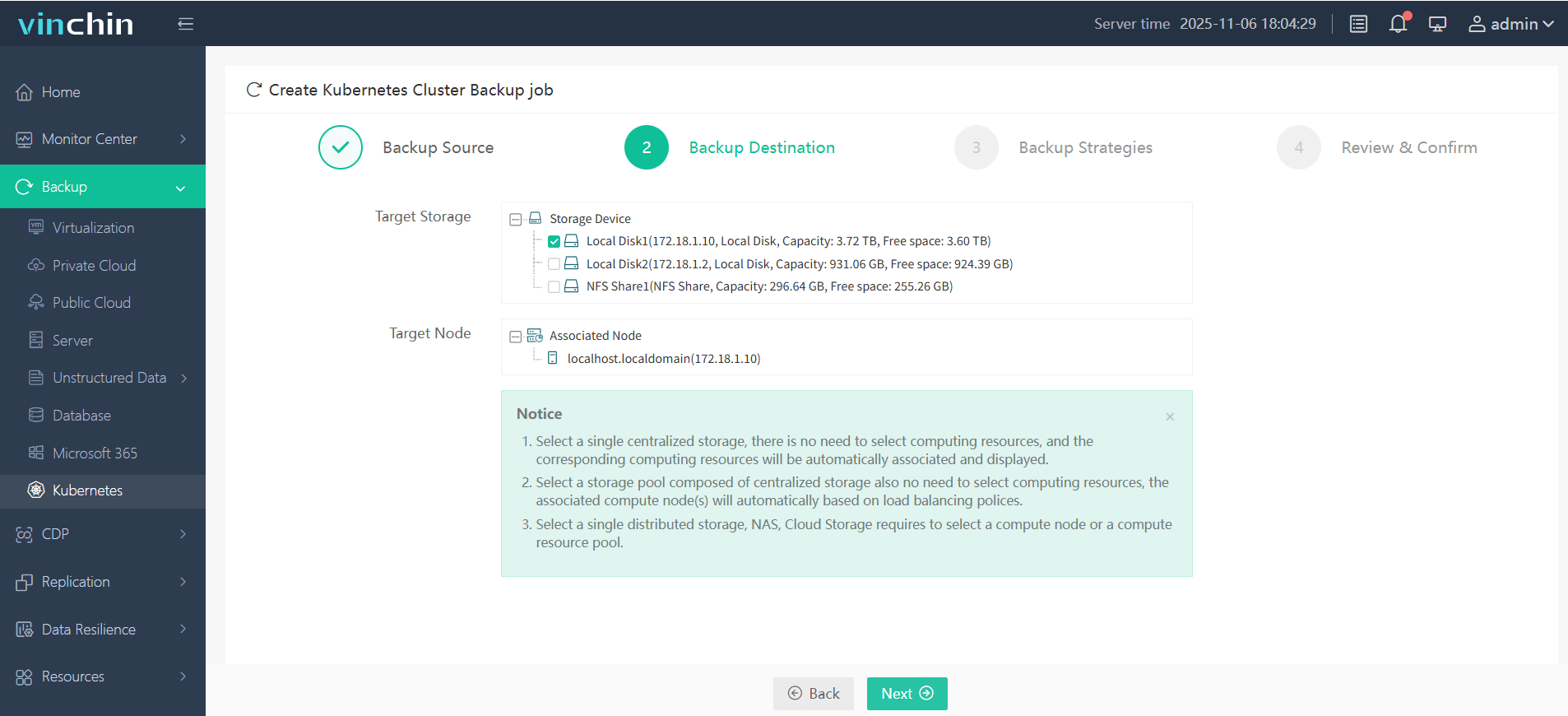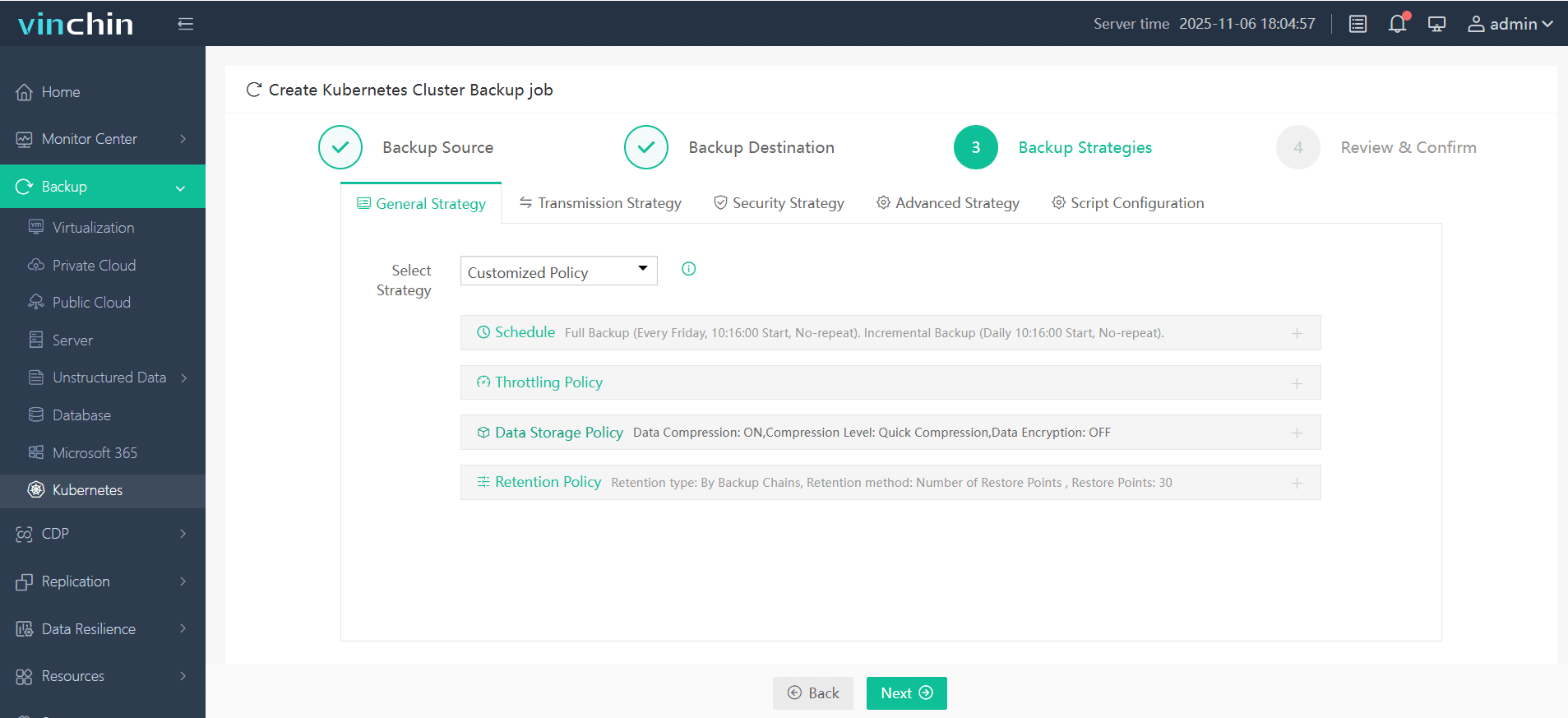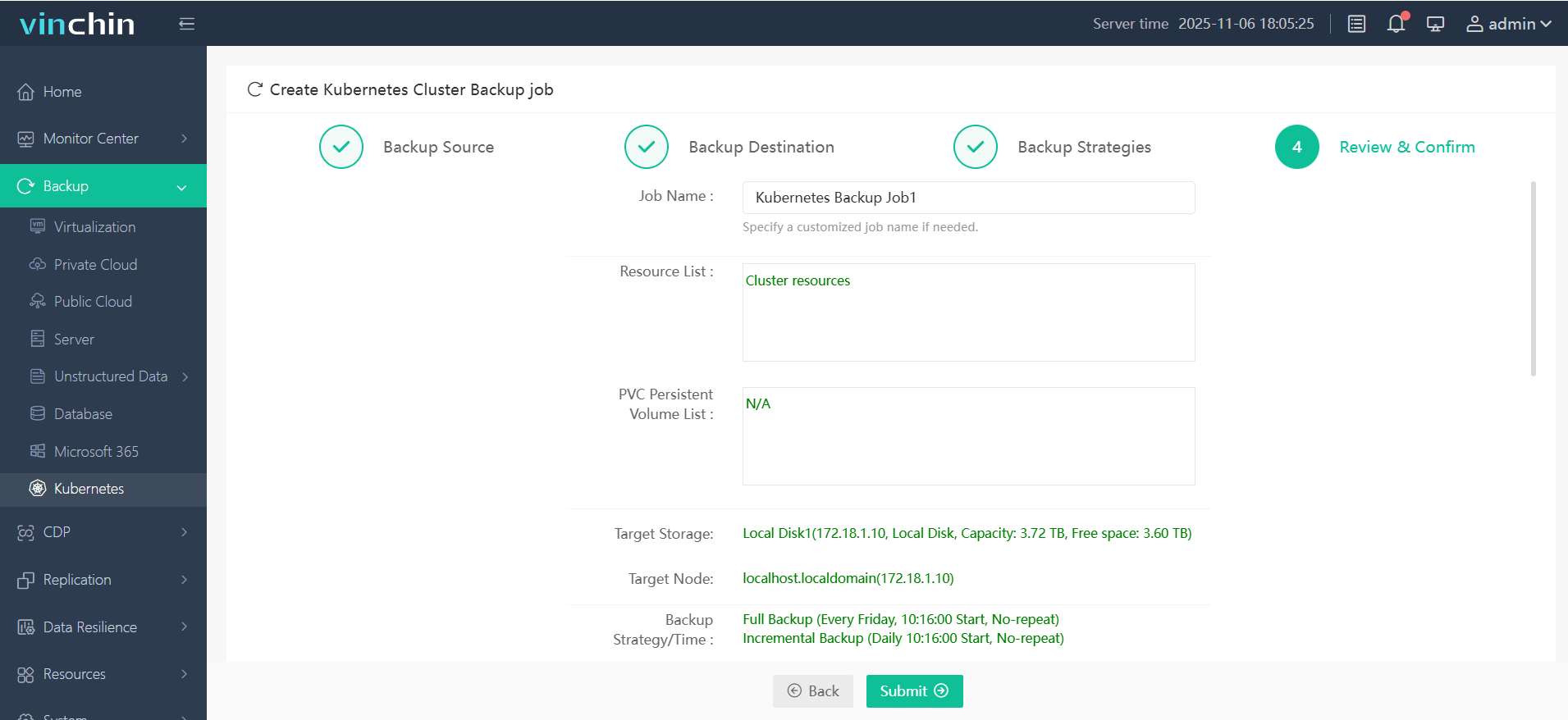-
What is Kubernetes Native Backup?
-
Why Use Native Backup Methods?
-
Method 1: Using Velero for Native Backup
-
Method 2: Using Stash by AppsCode for Native Backup
-
Vinchin Backup & Recovery – Enterprise-Level Protection Made Simple
-
Kubernetes Native Backup FAQs
-
Conclusion
Kubernetes has revolutionized application deployment by making workloads portable, scalable, and resilient. But this flexibility brings new risks—data loss from failed pods, accidental deletions, or cluster outages can happen fast in such dynamic environments. Traditional backup methods often miss critical Kubernetes resources or fail to restore entire applications as expected. That’s why mastering Kubernetes native backup is now a must-have skill for every operations administrator who wants to avoid downtime and meet compliance requirements.
What is Kubernetes Native Backup?
Kubernetes native backup means using tools designed specifically for the Kubernetes platform itself—not generic VM or file-level solutions retrofitted for containers. These tools interact directly with Kubernetes APIs to capture everything: deployments, services, secrets, persistent volumes—even custom resources unique to your environment.
Unlike legacy approaches that might only back up disk data or static files, native solutions understand how your cluster works as a whole system. They let you back up both configuration (like YAML manifests) and stateful data together so you can recover complete applications quickly after an incident.
Why Use Native Backup Methods?
Native backup methods are purpose-built for the fast-changing nature of container orchestration platforms like Kubernetes. They automatically discover new resources as they're created—no need to update scripts every time your team deploys something new.
These tools also support advanced features like namespace-level backups or label selectors so you can target exactly what matters most in your environment. You get tighter integration with security controls through Role-Based Access Control (RBAC), ensuring only authorized users manage backups.
From an operational perspective, native backups help reduce manual work by supporting automation pipelines common in DevOps workflows—and they fit right into CI/CD processes without extra glue code.
Method 1: Using Velero for Native Backup
Velero is one of the most widely adopted open-source tools for Kubernetes native backup today. It lets you protect both cluster resources (like deployments/services) and persistent volumes across cloud providers or on-premises clusters—all through simple commands that use standard Kubernetes APIs.
Before starting with Velero:
Make sure you have
kubectlconfigured with admin accessYour cluster should have internet connectivity if using cloud storage
Set up credentials for your chosen object storage backend
Installing Velero
To install Velero on Linux using AWS S3 as an example:
velero install \ --provider aws \ --plugins velero/velero-plugin-for-aws:v1.8.0 \ --bucket <YOUR_BUCKET> \ --backup-location-config region=<YOUR_REGION> \ --snapshot-location-config region=<YOUR_REGION> \ --secret-file <PATH_TO_CREDENTIALS>
Replace <YOUR_BUCKET>, <YOUR_REGION>, <PATH_TO_CREDENTIALS> with real values from your environment setup guide.
After running this command:
You should see confirmation messages indicating successful deployment of Velero components (
Deployment,ServiceAccount, etc.) in theveleronamespaceCheck pod status using
kubectl get pods -n velero
Creating Backups
To create a full-cluster backup:
velero backup create my-backup
This command triggers a snapshot of all supported resources—including persistent volume claims if your storage class allows it.
Want just one namespace? Try:
velero backup create my-backup --include-namespaces my-namespace
Or use labels:
velero backup create my-backup --selector app=my-app
You’ll see output confirming the job was created; check progress via:
velero backup describe my-backup --details
Scheduling Automatic Backups
Automate regular protection by scheduling jobs:
velero schedule create daily-backup --schedule "0 2 * * *"
This sets up daily runs at 2 AM UTC—adjust timing as needed per local policy.
Restoring from Backups
When disaster strikes—or during testing—you can restore everything backed up earlier:
velero restore create --from-backup my-backup
Restoration recreates all captured objects; monitor progress via kubectl get restores -n velero.
Method 2: Using Stash by AppsCode for Native Backup
Stash by AppsCode takes a different approach—it uses Custom Resource Definitions (CRDs) so all configuration lives inside your cluster alongside other workloads. This makes it easy to automate protection through GitOps workflows while keeping everything declarative and version-controlled.
Before deploying Stash:
Ensure Helm is installed locally (
helm version)You have admin privileges on your target cluster (
kubectl config current-context)
Installing Stash Operator Pattern Explained
Stash runs as an operator—a controller watching custom resources you define (like Repository or BackupConfiguration). Operators extend core Kubernetes functionality without modifying upstream code; they react automatically when you apply new CRDs describing desired state changes such as initiating a scheduled backup job.
Install Stash operator into the kube-system namespace:
helm repo add appscode https://charts.appscode.com/stable/ helm repo update helm install stash appscode/stash --namespace kube-system
Check readiness via:
kubectl get pods -n kube-system | grep stash
Configuring Repositories & Scheduling Backups
First define where backups go—a Repository CRD pointing at S3-compatible storage:
apiVersion: stash.appscode.com/v1alpha1 kind: Repository metadata: name: s3-repo namespace: demo # make sure this namespace exists! spec: backend: s3: endpoint: s3.amazonaws.com bucket: <YOUR_BUCKET> region: <YOUR_REGION> prefix: backups storageSecretName: s3-secret # secret must exist in 'demo'
Apply this manifest after creating any required secrets (kubectl apply -f repository.yaml).
Next set up automated schedules using BackupConfiguration CRDs:
apiVersion: stash.appscode.com/v1beta1 kind: BackupConfiguration metadata: name: cluster-resource-backup namespace: demo spec: repository: name: s3-repo schedule: "0 2 * * *" # daily at 2AM UTC task: name: kubedump-backup-0.1.0 retentionPolicy: name: keep-last-5 keepLast: 5 prune: true
Each time this runs it creates a new BackupSession object tracking results—check them via kubectl get backupsessions -n demo.
To restore data later define RestoreSession CRDs referencing specific sessions/backups previously created.
Vinchin Backup & Recovery – Enterprise-Level Protection Made Simple
For organizations seeking more robust capabilities beyond open-source tooling, Vinchin Backup & Recovery delivers professional-grade protection tailored specifically for enterprise Kubernetes environments. As an advanced solution, Vinchin Backup & Recovery offers fine-grained backup and restore at multiple levels (cluster, namespace, application, PVC), policy-driven automation including scheduled and one-off jobs, secure cross-cluster/version recovery for seamless migrations, comprehensive data security features such as encryption/WORM/encrypted transmission, and high-performance optimization through configurable multithreading and concurrent transfer streams. Together these features ensure reliable compliance-ready protection while maximizing efficiency across complex hybrid infrastructures.
The intuitive web console streamlines operations—in just four steps
Step 1. Select the backup source

Step 2. Choose the backup storage

Step 3. Define the backup strategy

Step 4. Submit the job

Recognized globally with strong customer adoption and top industry ratings, Vinchin Backup & Recovery offers a fully-featured free trial valid for 60 days—download now to experience enterprise-class data protection firsthand!
Kubernetes Native Backup FAQs
Q1: Can I verify that my scheduled kubernetes native backups actually contain all required resources?
Yes—run test restores regularly into isolated namespaces/clusters then compare restored objects against production manifests/resources before relying on them in disaster scenarios.
Q2: How do kubernetes native backups affect node performance during peak business hours?
Backups may temporarily increase CPU/disk/network usage; schedule large jobs outside peak times where possible—or throttle concurrency settings within tool configs if available—to minimize user impact.
Q3: What's the best way to monitor ongoing kubernetes native backup health?
Integrate Prometheus-compatible metrics exposed by most operators/tools into Grafana dashboards then set alerts based on failure rates/job durations/completion status indicators visible there.
Conclusion
Kubernetes native backup keeps modern apps safe against unexpected loss while fitting seamlessly into DevOps workflows—with less manual effort than legacy methods ever could offer! For advanced needs beyond open-source basics try Vinchin's robust platform today—it makes enterprise-grade protection simple from day one!
Share on:







